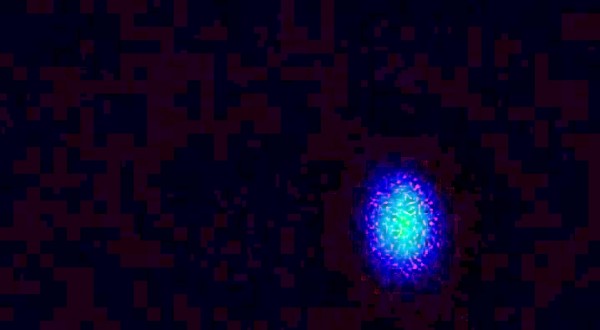By Arthur Dominic J. Villasanta , | May 05, 2017

The first Laser Light at the European XFEL, recorded by an X-ray detector at the end of the tunnel.
The European XFEL, the biggest X-ray laser in the world, has generated its first X-ray laser light, thereby reaching the last major milestone before its official opening in September.
The X-ray light had a wavelength of 0.8 nm, or about 500 times shorter than that of visible light. At first lasing, the laser had a repetition rate of one pulse per second, which will later increase to 27,000 per second.
Like Us on Facebook
XFEL is located inside a 3.4 km long facility, most of which is located in underground tunnels.
The X-ray laser light of the European XFEL is extremely intense, and a billion times brighter than that of conventional synchrotron light sources.
The X-ray laser light of the European XFEL was generated from an electron beam from a superconducting linear accelerator, the key component of the X-ray laser. The German research center DESY, the largest shareholder of the European XFEL, activated the accelerator at the end of April.
The 3.4 km long European XFEL is the largest and most powerful of the five X-ray lasers worldwide, with the ability to generate the short pulses of hard X-ray light.
With more than 27,000 light flashes per second instead of the previous maximum of 120 per second, an extremely high luminosity, and the parallel operation of several experiment stations, will make it possible for scientists investigate more limited samples and perform their experiments more quickly.
The facility will increase the amount of beamtime available, as the capacity at other X-ray lasers worldwide has been eclipsed by demand, and facilities have been overbooked.
The achievable laser light wavelength corresponds to the size of an atom. This means the X-rays can be used to make pictures and films of the nanocosmos at atomic resolution. The X-rays can reveal biomolecules from which better a understanding of the basis of illnesses or the development of new therapies can be developed.
Other opportunities include research into chemical processes and catalytic techniques, with the goal of improving their efficiency or making them more environmentally friendly; materials research and the investigation of conditions similar to the interior of planets.
"This is an important moment that our partners and we have worked towards for many years," said European XFEL Managing Director Prof. Robert Feidenhans.
"The colleagues involved at European XFEL, DESY, and our international partners have accomplished outstanding work. This is also a great success for scientific collaboration in Europe and across the world.
"We can now begin to direct the X-ray flashes with special mirrors through the last tunnel section into the experiment hall, and then step by step start the commissioning of the experiment stations. I very much look forward to the start of international user operation, which is planned for September."
-
Use of Coronavirus Pandemic Drones Raises Privacy Concerns: Drones Spread Fear, Local Officials Say

-
Coronavirus Hampers The Delivery Of Lockheed Martin F-35 Stealth Fighters For 2020

-
Instagram Speeds Up Plans to Add Account Memorialization Feature Due to COVID-19 Deaths

-
NASA: Perseverance Plans to Bring 'Mars Rock' to Earth in 2031

-
600 Dead And 3,000 In The Hospital as Iranians Believed Drinking High-Concentrations of Alcohol Can Cure The Coronavirus

-
600 Dead And 3,000 In The Hospital as Iranians Believed Drinking High-Concentrations of Alcohol Can Cure The Coronavirus

-
COVID-19: Doctors, Nurses Use Virtual Reality to Learn New Skills in Treating Coronavirus Patients










